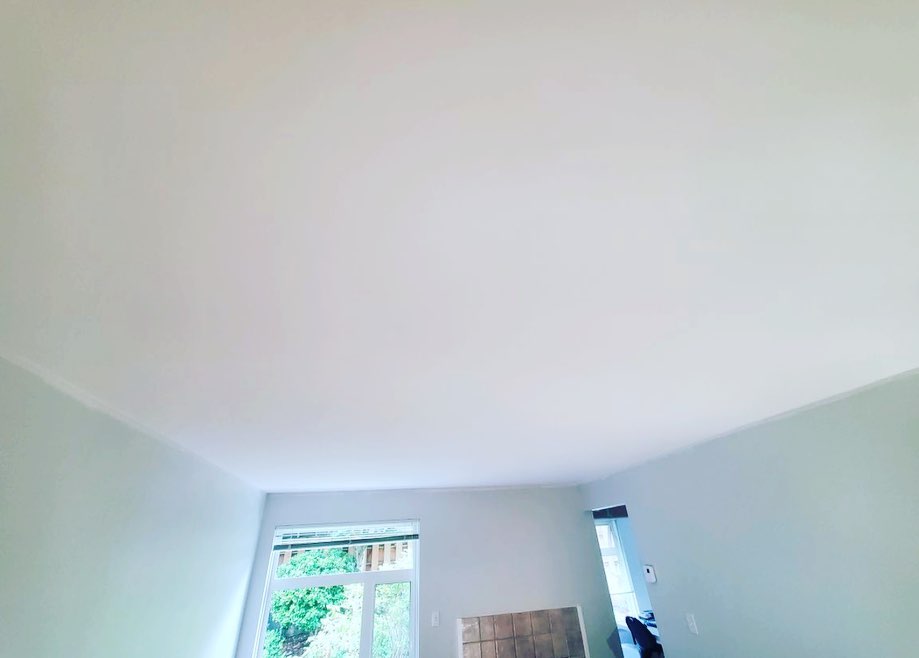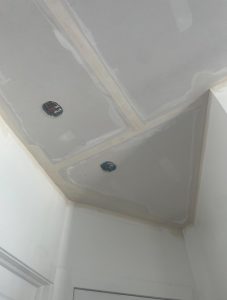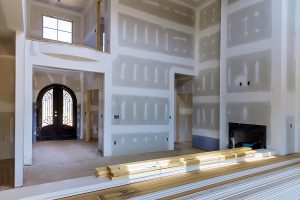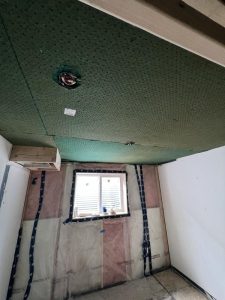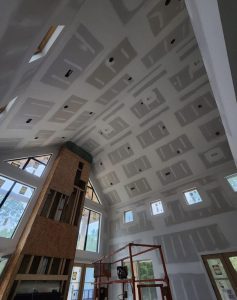Texture removal is a significant undertaking with far-reaching implications for your home’s aesthetics, functionality, and overall value. By exploring the subject in greater detail, we can better understand how texture removal can shape your home improvement project.
1. Aesthetics and Modernization
Texture removal plays a pivotal role in enhancing the aesthetics of your home, particularly if you have an older property with dated textures such as popcorn ceilings or heavy stucco walls. These textures were popular in past decades but can make your home appear old-fashioned today.
When you remove these textures, your home takes on a more modern and streamlined appearance. Smooth ceilings and walls offer a timeless elegance that suits various design styles, from contemporary to traditional. This aesthetic transformation can significantly impact your overall satisfaction with your living space.
2. Painting and Decorating
One of the most immediate benefits of texture removal is the ease of painting and decorating your interior spaces. Smooth surfaces provide an even and consistent canvas for paint application. This is particularly advantageous if you enjoy frequently updating your home’s color scheme or want to experiment with different design elements.
With textured surfaces, painting can be a challenge. The uneven surface can cause the paint to adhere unevenly, leading to an inconsistent and unattractive finish. Additionally, textured surfaces tend to absorb more paint, increasing your material costs.
When you remove texture, painting becomes a breeze. You can achieve professional-quality results with less effort and paint, allowing you to explore various colors, finishes, and techniques to personalize your living spaces.
3. Design Flexibility
Texture removal opens up a world of design possibilities. Smooth surfaces serve as a blank canvas that allows you to unleash your creativity and bring your interior design visions to life. Here are a few ways texture removal enhances design flexibility:
Wall Treatments: Smooth walls provide the ideal backdrop for various wall treatments, such as wallpapers, wainscoting, and decorative paneling. These elements can add depth, texture, and visual interest to your rooms.
Molding and Trim: Smooth surfaces accentuate the beauty of architectural details like crown molding, chair rails, and baseboards. You can choose from a wide range of molding profiles to enhance the character of your space.
Custom Finishes: Texture removal enables you to experiment with custom finishes, such as faux painting, murals, or intricate stenciling. These techniques can elevate your home’s design to a new level of sophistication.
4. Lighting Enhancement
The impact of texture removal extends to the quality of lighting in your home. Smooth surfaces reflect light more evenly and efficiently than textured ones. As a result, rooms with smooth walls and ceilings tend to feel brighter and more spacious. Here’s how texture removal can enhance your lighting:
Improved Natural Light: When natural light enters a room, it bounces off smooth surfaces, creating a sense of openness and airiness. Removing texture can maximize the benefits of natural light, reducing the need for artificial lighting during the day.
Enhanced Artificial Lighting: Whether you rely on overhead fixtures, lamps, or wall sconces, the quality of artificial lighting is influenced by the surfaces it interacts with. Smooth walls and ceilings create a more reflective environment, making artificial lighting more effective and pleasant.
Ambient and Task Lighting: In rooms where ambient and task lighting are crucial, such as kitchens and home offices, smooth surfaces allow for more precise placement and distribution of lighting fixtures.
5. Maintenance and Cleanliness
Texture removal can simplify the ongoing maintenance and cleanliness of your home. Textured surfaces, whether they are stippled, popcorn, or heavily textured walls, tend to trap dust, dirt, and allergens more easily than smooth ones. Here are the maintenance-related benefits of texture removal:
Easier Cleaning: Smooth surfaces are a breeze to clean. Dust and dirt can be wiped away with minimal effort, and you won’t encounter the nooks and crannies that textured surfaces often have.
Allergen Reduction: Textured surfaces can harbor allergens like dust mites and pet dander, contributing to poor indoor air quality. Removing texture can reduce the accumulation of allergens, making your home healthier for occupants with allergies or respiratory conditions.
Long-Term Durability: Over time, textured surfaces may wear unevenly or become damaged, requiring frequent touch-ups or repairs. Smooth surfaces are more durable and resistant to wear and tear, reducing the need for ongoing maintenance.
6. Resale Value
If you’re considering texture removal as part of a home improvement project with the intention of selling your property, it’s important to understand how it can impact your home’s resale value. While the impact on resale value can vary depending on factors such as location and market conditions, there are some general considerations:
Increased Appeal: Many potential homebuyers prefer homes with clean, neutral surfaces that they can personalize to their liking. Smooth walls and ceilings can appeal to a broader range of buyers, potentially leading to a quicker sale.
Competitive Advantage: In a competitive real estate market, a well-maintained and updated home can stand out from the competition. Texture removal, along with other modernization efforts, can give your home a competitive advantage.
Higher Appraisal Value: Texture removal, when done effectively, can contribute to a higher appraisal value for your property. Appraisers often consider the condition and aesthetics of a home’s interior during the appraisal process.
It’s essential to balance your texture removal project’s cost against the potential resale value increase. Consulting with a real estate agent or appraiser in your area can provide valuable insights into the expected return on investment for texture removal in your specific market.
7. Repair and Renovation
The condition of your walls and ceilings plays a significant role in the feasibility and cost of repair and renovation projects. Smooth surfaces offer several advantages in this regard:
Easier Repairs: Smooth walls and ceilings are easier to repair if they become damaged. Whether you need to patch a small hole, fix a crack, or address minor imperfections, the process is generally straightforward and yields seamless results.
Renovation Opportunities: If you have plans for extensive renovations, such as updating your kitchen or bathroom, smooth surfaces provide a solid foundation. They allow for the precise installation of new fixtures, cabinetry, backsplashes, and other elements that contribute to your renovation’s success.
Consistency in Finish: When you have a consistent and smooth surface, renovations and updates result in a more polished and cohesive appearance. This consistency is especially important in open-concept spaces, where transitions between rooms are more visible.
8. Health and Allergies
For individuals with allergies or respiratory issues, texture removal can have a significant impact on indoor air quality and overall health. Textured surfaces, especially older ones, can harbor dust, allergens, and even mold in some cases. Here’s how texture removal can benefit health:
Reduced Allergen Exposure: Texture removal reduces the accumulation of dust, dust mites, pet dander, and other allergens on surfaces. This can lead to a noticeable improvement in indoor air quality, providing relief for allergy sufferers.
Preventing Mold Growth: In areas with high humidity, textured surfaces can trap moisture, creating an environment conducive to mold growth. Smoother, sealed surfaces are less prone to mold issues, contributing to a healthier indoor environment.
Enhanced Respiratory Comfort: For individuals with respiratory conditions like asthma, the reduction in allergens and irritants can lead to improved respiratory comfort and a decreased reliance on medication.
9. Cost and Time Considerations
Before embarking on a texture removal project, it’s essential to understand the associated costs and time requirements. The scope of the project, the type of texture you’re removing, and whether you choose to DIY or hire professionals can all influence the financial and time aspects.
Labor and Material Costs: The cost of texture removal can vary significantly depending on the size of the project and the type of texture you’re dealing with. Some textures, like popcorn ceilings, may contain asbestos, which can increase removal costs due to safety precautions. Additionally, you’ll need to budget for materials like joint compound, sandpaper, and paint to achieve smooth surfaces.
DIY vs. Professional: While some homeowners opt for a DIY approach to texture removal to save money, it’s important to note that it can be a labor-intensive and messy process. Hiring professionals can ensure a smoother and more efficient project but will come at an additional cost.
Time Investment: Texture removal can be time-consuming, particularly if you’re tackling it as a DIY project. The size of the space and the complexity of the texture will influence the amount of time required. Professional contractors can typically complete the job more quickly.
Preparation and Cleanup: Proper preparation and cleanup are essential for a successful texture removal project. This includes protecting furniture and floors, sealing off the area, and disposing of debris properly.
In conclusion, texture removal is a multifaceted aspect of home improvement that can have a profound impact on your living space. It influences aesthetics, lighting, maintenance, resale value, and even health considerations. The decision to remove texture should be made based on your specific goals, budget, and the condition of your home.
Before embarking on a texture removal project, it’s advisable to consult with experts in the field, such as contractors, interior designers, or real estate professionals. They can provide guidance tailored to your unique circumstances and help you make an informed decision about how texture removal fits into your overall home improvement plans. Whether you prioritize aesthetics, functionality, or health, texture removal can be a transformative step toward creating the home you desire.

